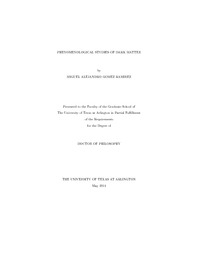
ATTENTION: The works hosted here are being migrated to a new repository that will consolidate resources, improve discoverability, and better show UTA's research impact on the global community. We will update authors as the migration progresses. Please see MavMatrix for more information.
Show simple item record
| dc.contributor.author | Gomez Ramirez, Miguel Alejandro | en_US |
| dc.date.accessioned | 2014-07-14T20:22:54Z | |
| dc.date.available | 2014-07-14T20:22:54Z | |
| dc.date.issued | 2014-07-14 | |
| dc.date.submitted | January 2014 | en_US |
| dc.identifier.other | DISS-12615 | en_US |
| dc.identifier.uri | http://hdl.handle.net/10106/24413 | |
| dc.description.abstract | It is common knowledge that eighty percent of the matter in our Universe consists of a mysterious substance called ``dark matter'' (DM) which has only been detected through its gravitational interactions. The ``Standard Model'' (SM) of particle physics, despite its extremely impressive successes, does not have a good candidate particle to fit the DM requirements. If DM is made up of a particle which interacts weakly and it has a mass on the same scale as other SM particles, it should be detectable.In this work, two different phenomenological studies of DM are performed. The first possibility is a weakly-interacting particle being detected when a high density of particles and enough energy is present. These conditions are met by objects called ``active galactic nuclei'' (AGN). AGN are the extremely violent central regions of very large galaxies, and in these regions highly-energetic ``jets'' of particles are accelerated. It was thought that the possibility the jet particles interact with the surrounding DM producing photons with very distinctive characteristics. A comparison of predicted values with current data is made and it is shown that the prospects for detecting DM in this way are promising in the near future.In the second approach instead of working with complicated fully developed models, only the minimal content needed to account for DM is added to the SM. The strength of these ``simplified'' models is that they encompass the interactions and parameter spaces of well-motivated models such as supersymmetry. A simplified model of fermionic DM candidate which couples exclusively to the right handed top quark via a color-charged scalar is considered (motivated by EW symmetry breaking). It is shown that this model can account for the totality of DM and the chances of detection in the near future are very good. | en_US |
| dc.description.sponsorship | Jackson, Christopher | en_US |
| dc.language.iso | en | en_US |
| dc.publisher | Physics | en_US |
| dc.title | Phenomenological Studies Of Dark Matter | en_US |
| dc.type | Ph.D. | en_US |
| dc.contributor.committeeChair | Jackson, Christopher | en_US |
| dc.degree.department | Physics | en_US |
| dc.degree.discipline | Physics | en_US |
| dc.degree.grantor | University of Texas at Arlington | en_US |
| dc.degree.level | doctoral | en_US |
| dc.degree.name | Ph.D. | en_US |
Files in this item
- Name:
- GomezRamirez_uta_2502D_12615.pdf
- Size:
- 67.23Mb
- Format:
- PDF
This item appears in the following Collection(s)
Show simple item record


